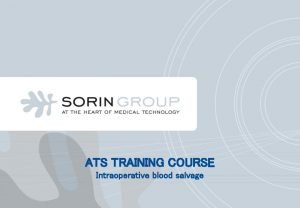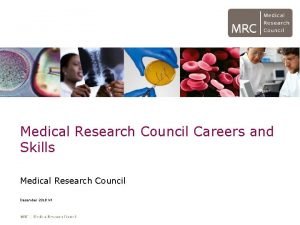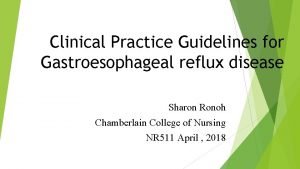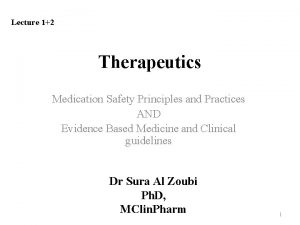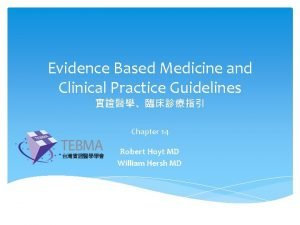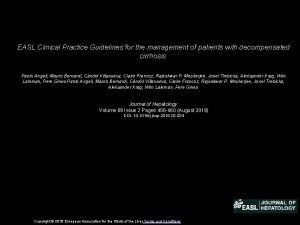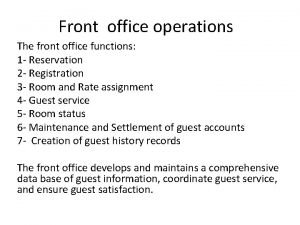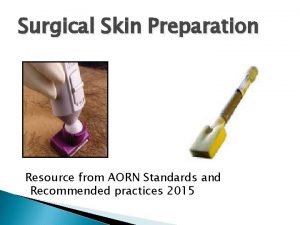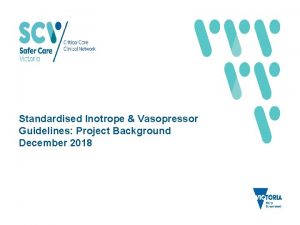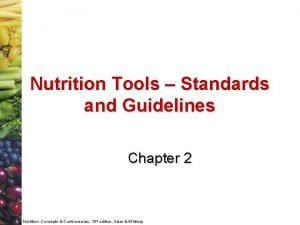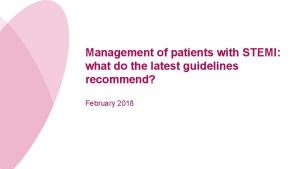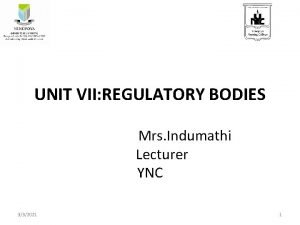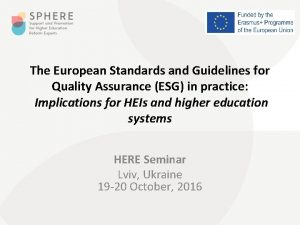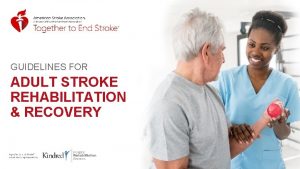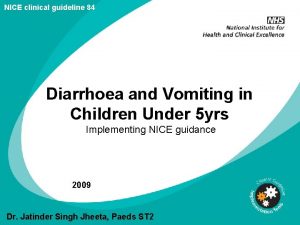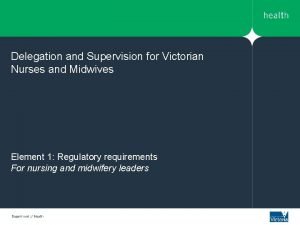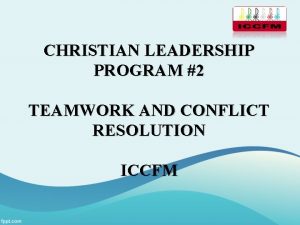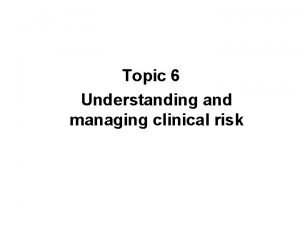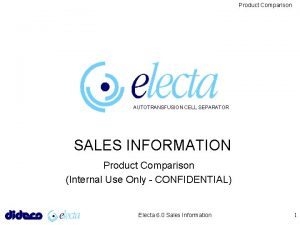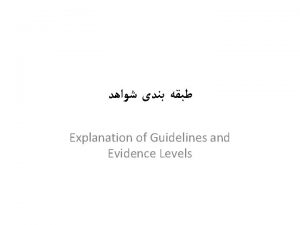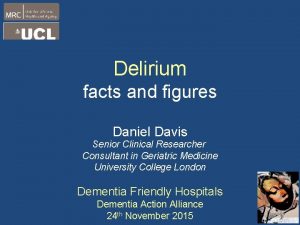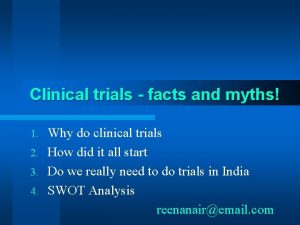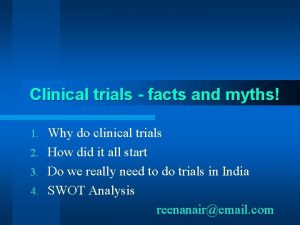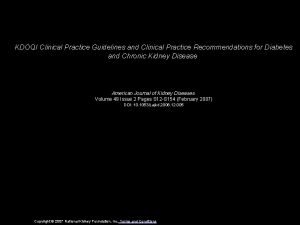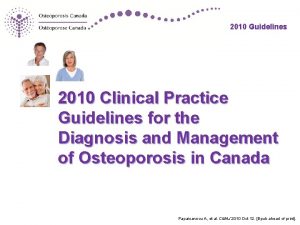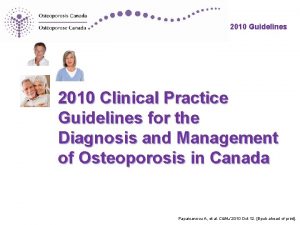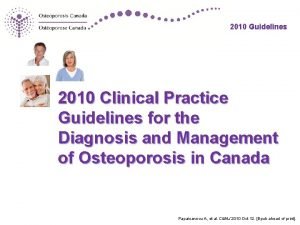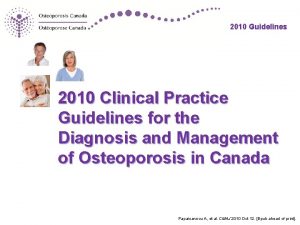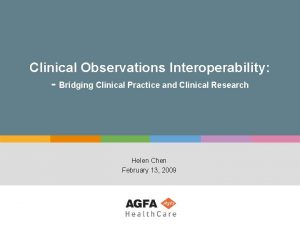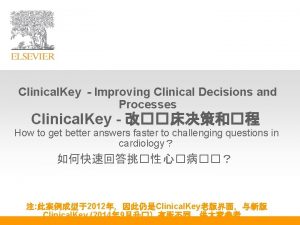AUTOTRANSFUSION Facts and Guidelines Christian Chlela Senior Clinical





































- Slides: 37

AUTOTRANSFUSION Facts and Guidelines Christian Chlela Senior Clinical Expert Sorin Group

AUTOTRANSFUSION FOR A BETTER PATIENT OUTCOME … 1 - DEFINITION : Autotransfusion is a process when a person receives their own blood for a transfusion, instead of banked donor blood. Blood can be pre-donated before a surgery, or can be collected during and after the surgery using a device commonly known as the Cell Salvage device. 3 rd Perfusion Symposium Antalya, TURKEY 2015 1

AUTOTRANSFUSION FOR A BETTER PATIENT OUTCOME … 2 - HISTORY OF AUTOTRANSFUSION : • First Autologous transfusion was done by James Blundell in 1818 before the discovery of blood groups. • Anglo-saxon were the first to publish articles reporting Autotransfusion in 1874. • Blood salvage was first reported in American literature in 1917. • In 1974 Cell saver system was introduced 3 rd Perfusion Symposium Antalya, TURKEY 2015 2

AUTOTRANSFUSION FOR A BETTER PATIENT OUTCOME … 3 - INDICATION AND TRIGGER FOR AUTOTRANSFUSION: • Anticipated blood loss is equal to or greater than 800 ml • Procedures where 2 units of blood are routinely cross matched • Procedures where 20% of the patients are routinely transfused • Emergency procedures • Patients with rare blood types or incompatibilities • Patients with religious objections to allogeneic blood components 3 rd Perfusion Symposium Antalya, TURKEY 2015 3

AUTOTRANSFUSION FOR A BETTER PATIENT OUTCOME … 4 - IN WHICH SURGERY CAN WE USE AUTOTRANSFUSION: • Cardiac Surgery: Coronary Artery Bypass, Cardiac Valvular Repair / Replacement, … • Trauma: Chest Injuries, Liver Fractures, Kidney Fractures, Major Vessel Lacerations, Gun Shot Wounds, Stab Wounds, . . • Orthopedic: Spinal Instrumentation, Spinal Fusion, Total hip replacement, Total knee replacement, … • Vascular Surgery: Aneurysm, Aorto-Femoral Reconstruction, Major Vessel Resection …. • Other: Ectopic Pregnancy, Liver Resection (Non-Malignant), Liver Transplant, Nephrectomy (Non-Malignant), Speno-Renal Shunts… 3 rd Perfusion Symposium Antalya, TURKEY 2015 4

AUTOTRANSFUSION FOR A BETTER PATIENT OUTCOME … 5 - Contraindications • The use of blood recovered from the operative field is contraindicated in the presence of bacterial contamination or malignancy. The use of autotransfusion in the presence of such contamination may result in the dissemination of pathologic microorganisms and / or malignant cells. 3 rd Perfusion Symposium Antalya, TURKEY 2015 5

AUTOTRANSFUSION FOR A BETTER PATIENT OUTCOME … 5. 1 - Exceptions to those contraindications are under investigations: 5. 1. 1 - Malignancy: • Blood irradiation for intraoperative autotransfusion in cancer surgery demonstration of efficient elimination of contaminating tumor cells. Hansen E, Knuechel R, Altmeppen J, Taeger K. Department of Anesthesiology, University of Regensburg, Germany. Transfusion. 1999 Jun; 39(6): 608 -15. • Intraoperative blood salvage in cancer surgery: safe and effective? Hansen E, Bechmann V, Altmeppen J. Department of Anesthesiologie, University of Regensburg, Germany. Transfus Apher Sci. 2002 Oct; 27(2): 153 -7. According to our experience with more than 700 procedures the combination of blood salvage with blood irradiation also is very effective in saving blood resources. With this autologous, fresh, washed RBC a blood product of excellent quality is available for optimal hemotherapy in cancer patients. 3 rd Perfusion Symposium Antalya, TURKEY 2015 6

AUTOTRANSFUSION FOR A BETTER PATIENT OUTCOME … • 5. 1. 1 - Malignancy: • Intraoperative cell salvage during radical cystectomy does not affect long-term survival. Nieder AM, Manoharan M, Yang Y, Soloway MS. Department of Urology, University of Miami Miller School of Medicine, Miami, Florida 33140, USA. Urology. 2007 May; 69(5): 881 -4. • Blood salvage use in gynecologic oncology. Nagarsheth NP, Sharma T, Shander A, Awan A. Division of Gynecologic Oncology, Department of Obstetrics, Gynecology and Reproductive Science, Mount Sinai Medical Center, New York 10029 -6574, USA. Transfusion. 2009 Oct; 49(10): 2048 -53. Epub 2009 Jun 23. In this series of patients undergoing surgery for malignancies on the gynecologic oncology service, blood salvage with LRF was not definitively associated with hematogenous dissemination. 3 rd Perfusion Symposium Antalya, TURKEY 2015 7

AUTOTRANSFUSION FOR A BETTER PATIENT OUTCOME … 5. 1. 2 Bacterial contamination: • Intraoperative blood salvage and leukocyte depletion during liver transplantation with bacterial contamination. Liang TB, Li JJ, Li DL, Liang L, Bai XL, Zheng SS. Department of Hepatobiliary and Pancreatic Surgery, Clin Transplant. 2010 Mar 1; 24(2): 265 -72. Epub 2009 Sep 24. CONCLUSIONS: Autotransfusion devices with an additional LDF could significantly eliminate bacterial contaminants of shed blood during OLT 3 rd Perfusion Symposium Antalya, TURKEY 2015 8

AUTOTRANSFUSION FOR A BETTER PATIENT OUTCOME … 5. 2. 1: Recommandations: Despite the many studies undergoing to bypass those contraindications all major companies do not recommend the usage of there Autotransfusion device in case of contamination or malignancy. 5. 2. 2 Emergency: Although there are contraindications In life saving situations with the consent of the surgeon, Autotransfusion can be utilized in the presence of the previous stated contraindications. 3 rd Perfusion Symposium Antalya, TURKEY 2015 9

AUTOTRANSFUSION FOR A BETTER PATIENT OUTCOME … 6 -Disadvantages: The disadvantage of autotransfusion is the depletion of plasma and platelets. The autotransfusion system removes the plasma and platelets, to eliminate activated clotting factors and activated platelets which would cause coagulopathy if they were reinfused to the patient. This disadvantage is only evident when very large blood losses occur. The autotransfusionist monitors blood loss and will recommend the transfusion of fresh frozen plasma (FFP) and platelets when the blood loss is over >40% of the blood volume. 3 rd Perfusion Symposium Antalya, TURKEY 2015 10

AUTOTRANSFUSION FOR A BETTER PATIENT OUTCOME … Why Autotransfusion and Blood Recovery? Accoding to AABB Guidelines for Blood Recovery and Reinfusion in Surgery and Trauma: • Issued in 2010, these Guidelines are a key document along with the 5 th Edition of AABB Standards for Perioperative Autologous Blood Collection and Administration, January 1, 2013. 3 rd Perfusion Symposium Antalya, TURKEY 2015 11

AUTOTRANSFUSION FOR A BETTER PATIENT OUTCOME … Why Autotransfusion and Blood Recovery? • Returns patient’s own blood avoiding or reducing complications such as transmission of infectious agents • Minimizes immunosuppressive effects of allogeneic blood • Immediate availability of blood for patients with compatibility issues • Serves as an acceptable alternative for patients with religious objections to allogeneic transfusion AABB Guidelines 2010, pg. 1 3 rd Perfusion Symposium Antalya, TURKEY 2015 12

AUTOTRANSFUSION FOR A BETTER PATIENT OUTCOME … • Problems with stored p. RBC’s 1 - Reduced ability of Hgb to release bound oxygen at tissue level (2, 3 DPG) 2, 3 DPG levels become undetectable after two weeks of storage. Levels are restored within 72 hours after transfusion Does red blood cell storage affect clinical outcome? When in doubt, do the experiment. Transfusion Vol 49 July 2009 3 rd Perfusion Symposium Antalya, TURKEY 2015 13

AUTOTRANSFUSION FOR A BETTER PATIENT OUTCOME … Problems with stored p. RBC’s 1. Reduced ability of Hgb to release bound oxygen at tissue level (2, 3 DPG). 2. Reduced RBC deformability = potential to block capillary beds 3 rd Perfusion Symposium Antalya, TURKEY 2015 14

AUTOTRANSFUSION FOR A BETTER PATIENT OUTCOME … RBC squeezing through a capillary bed 3 rd Perfusion Symposium Antalya, TURKEY 2015 15

AUTOTRANSFUSION FOR A BETTER PATIENT OUTCOME … 3 rd Perfusion Symposium Antalya, TURKEY 2015 16

AUTOTRANSFUSION FOR A BETTER PATIENT OUTCOME … Problems with stored p. RBC’s 1. Reduced ability of Hgb to release bound oxygen at tissue level (2, 3 DPG). . 2. Reduced RBC deformability = potential to block capillary beds 3. Storage lesion (age dependent defect) = potential to block capillary beds 1 - Transfusion 2006; 46: 2014– 27; 2 - Acta Anaesthesiol Scand 1996; 40: 496– 501. 3 -Anesth Analg 2004; 99: 2– 11. 4 -Transfusion 2004; 44: 1626– 34. 5 -JAMA 1993; 269: 3024– 9. 6 -Blood 2005; 105: 2266– 73. 7 -Chest 1999; 116: 1233– 9. 3 rd Perfusion Symposium Antalya, TURKEY 2015 17

AUTOTRANSFUSION FOR A BETTER PATIENT OUTCOME … • Transfusions & Infection Each unit of blood increases the risk of a nosocomial infection by up to 50%! Transfusion increases the risk of postoperative infections after cardiovascular surgery J Am Coll Surg 2006 Jan; 202 An alternative scoring system to predict risk for surgical site infection complicaating coronary artery bypass graft surgery Infect Control Hosp Epidemiol 2007 Oct; Transfusion of red cells is associated with increased incidence of bacterial infection after colorectal surgery; a prospective study Transfusion Feb 2003 Impact of allogenic packed red blood cell transfusion on nosocomial infection rates in the critically ill patient Crit Care Med 2002 Vol 30 #10 Transfusion Practice and Blood Stream Infections in Critically Ill Patients Chest 2005: 127 Blood transfusions correlate with infections in trauma patients in a dose-dependant manner Am Surg 2002: 68 3 rd Perfusion Symposium Antalya, TURKEY 2015 18

AUTOTRANSFUSION FOR A BETTER PATIENT OUTCOME … 838 ICU patients randomi zed into one of the following strategies: 1. Restrictive (transfusion for Hgb < 7 g/dl) 2. Liberal (transfusion for Hgb < 10 g/dl) 3 rd Perfusion Symposium Antalya, TURKEY 2015 19

AUTOTRANSFUSION FOR A BETTER PATIENT OUTCOME … TRICC Trial Results Complication Restrictive Incidence Liberal Incidence All Cardiac morbidities 13. 2% 21% Myocardial Infarction 0. 7% 2. 9% ARDS 7. 7% 11. 4% Pulmonary Edema 5. 3% 10. 7% 30 day Mortality 18. 7% 23. 3% A Multicenter, Randomized, Controlled Clinical Trial of Transfusion Requirements in Critical Care – Hebert et al New England Journal of Medicine 1999 3 rd Perfusion Symposium Antalya, TURKEY 2015

AUTOTRANSFUSION FOR A BETTER PATIENT OUTCOME … • Blood Transfusion Morbidity Study of 12, 000 CAB patients at Cleveland Clinic Post-Op Complication Non-Transfused patients New onset of renal failure requiring dialysis 0% 1. 81% Post-op ventilator support > 72 hours . 44% 9. 14% Serious post-op infection . 24% 5. 03% . 05% 3. 03% . 37% 2. 41% (includes sepsis and mediastinitis) Cardiac Morbidity (Includes Low Cardiac Index (< 1. 8), high dose inotropic support > 4 hrs, post-op MI with IABP or VAD) Neurologic Morbidity and mortality risk associated with red blood cell and blood-component transfusion in isolated coronary artery bypass grafting – Koch, et al. , Critical Care Medicine 2006 3 rd Perfusion Symposium Antalya, TURKEY 2015 21

AUTOTRANSFUSION FOR A BETTER PATIENT OUTCOME … • Blood Transfusion Morbidity Study of 12, 000 CAB patients at Cleveland Clinic “Transfusion is the single factor most reliably associated with increased postoperative morbid events. Each unit of red cells transfused is associated with incrementally increased risk for adverse outcome. ” Morbidity and mortality risk associated with red blood cell and blood-component transfusion in isolated coronary artery bypass grafting – Koch, et al. , Critical Care Medicine 2006 3 rd Perfusion Symposium Antalya, TURKEY 2015 22

AUTOTRANSFUSION FOR A BETTER PATIENT OUTCOME … • Transfusion-related acute lung injury (TRALI) is a serious complication of blood transfusions. • Acute lung injury (ALI) has been recognized as a consequence of blood transfusion (BT) since 1978; the Food and Drug Administration, has classified it as the third BT mortality issue, in 2004, and in first place related with ALI. • There is currently no screening test for the prevention of TRALI, and there is no single intervention that can eliminate the risk of TRALI (1: 2000) It can be mainly detected as: Acute respiratory distress syndrome (ARDS), • In USA, ARDS has an incidence of three to 22. 4 cases/100 000, with 58. 3 % mortality. 3 rd Perfusion Symposium Antalya, TURKEY 2015 23

AUTOTRANSFUSION FOR A BETTER PATIENT OUTCOME … 3 rd Perfusion Symposium Antalya, TURKEY 2015 24

Effect of Blood Transfusion on Long. Term Survival After Cardiac Operation • • 1915 CABG pts After correction for comorbidities and other factors, tx was still associated with a 70% increase in mortality (RR 1. 7; 95% CI 1. 4 to 2. 0; p 0. 001). Engoren MC et al. (MCO, Toledo) Ann Thorac Surg 2002; 74: 1180– 6

• • • 10, 289 CABG pts, 1995 – 2002 Perioperative RBC tx is associated with adverse outcome. Attention should be directed toward blood conservation methods and a more judicious use of PRBC. Cleveland Clinic, OHIO 0 1 2 3 -5 ≥ 6 Ann Thorac Surg 2006; 81: 1650 – 7

AUTOTRANSFUSION FOR A BETTER PATIENT OUTCOME … 3 rd Perfusion Symposium Antalya, TURKEY 2015 27

Recommendations for a Multimodality Blood Conservation Program FERRARIS ET AL. Ann Thorac Surg 2007; 83: S 27– 86 3 rd Perfusion Symposium Antalya, TURKEY 2015

Recommendations for a Multimodality Blood Conservation Program FERRARIS ET AL. Ann Thorac Surg 2007; 83: S 27– 86

AUTOTRANSFUSION FOR A BETTER PATIENT OUTCOME … More than 75 million units of blood are donated each year throughout the world. A significant proportion of these expose recipients of blood and blood products to unnecessary risk” WHO (World Health Organization) BLOOD TRANSFUSION SAFETY Information Sheet for National Health Authorities 3 rd Perfusion Symposium Antalya, TURKEY 2015 30

AUTOTRANSFUSION FOR A BETTER PATIENT OUTCOME … 3 rd Perfusion Symposium Antalya, TURKEY 2015 31

AUTOTRANSFUSION FOR A BETTER PATIENT OUTCOME … • Efficacy and cost-effectiveness of cell saving blood autotransfusion in adult lumbar fusion. C. Savvidou, S. N. Chatziioannou, A. Pilichou, S. G. Pneumaticos • summary. The objective of this study was to explore the use of cell saver blood autotransfusion in spinal surgery and to evaluate the efficacy and cost-effectiveness of cell saver blood autotransfusion during lumbar spine fusion in adults. Specific indications for the use of cell saver in adult lumbar fusion surgery have not yet been clearly determined. A total of 50 consecutive candidates for posterolateral fusion with internal fixation were prospectively randomized into either receiving perioperatively cell saving autotransfusion (Group A: 25 patients) or not (Group B: 25 patients). The use of cell saving technique did not exclude the use of allogenic blood transfusion. Surgical indications were spinal stenosis, spondylolisthesis, adolescent idiopathic scoliosis, degenerative scoliosis and fractures. Medical and financial data were recorded. A cost-analysis was performed. Patients in Group A received 880 ± 216 m. L from cell saver and 175 ± 202 m. L allogenic blood. The patients in Group B received 908 ± 244 m. L allogenic blood. Blood volumes data collected were expressed in mean ± SD values. The cost of blood transfusion in Group A was 995 ±€ 447 per patient and 1220 ± 269 in Group B (P < 0. 05). In elective lumbar fusion blood requirements can be satisfied with the use of autotransfusion. The use of cell saver appears to be useful and cost-effective during most elective lumbar fusions. 3 rd Perfusion Symposium Antalya, TURKEY 2015 32

AUTOTRANSFUSION FOR A BETTER PATIENT OUTCOME … A prospective study investigating the cost effectiveness of intraoperative blood salvage during liver transplantation. Phillips SD, Maguire D, Deshpande R, Muiesan P, Bowles MJ, Rela M, Heaton ND. Source Liver Transplantation Unit, Kings College Hospital, London, United Kingdom. Transplantation. 2006 Feb 27; 81(4): 536 -40. BACKGROUND: Adult orthotopic liver transplantation is associated with significant use of allogenic blood products, which places considerable demands on finite resources. This could be reduced by autologous red cell salvage use, and we evaluated its cost effectiveness in this prospective study. METHODS: Intraoperative autotransfusion was used in 660 adult liver transplant patients between January 1997 and July 2002. These included 134 with acute liver failure, 62 retransplants, 90 alcohol-related, 183 viral, 98 cholestatic chronic liver diseases, and 93 with other etiologies. RESULTS: The total volume of red blood cells transfused was 3641+/-315 ml, 2805+/-234 ml, 2603+/-443 ml, and 2785+/-337 ml for alcohol-related, viral, cholestatic, and others, respectively. Low preoperative hemoglobin was significantly associated with higher intraoperative transfusion requirements. Blood volumes transfused at retransplantation were significantly higher (7077+/-1110 ml vs. 2864+/-138 ml; P<0. 001) than for acute liver failure and chronic liver disease. Autologous blood volumes transfused were similar in all diagnostic groups, but were significantly greater in retransplantation (2754+/-541 ml vs. 1524+/-77 ml; P<0. 01). Venovenous bypass was significantly associated with higher transfusion requirements. Total savings per case were similar for all diagnostic groups but were greater in cases of retransplantation (864+/-222 pounds With the use of autologous transfusion over the study period, a cost saving of 131, 901 pounds (188, 618 US dollars) was achieved. (1235+/-317 US dollars) vs. 238+/-24 pounds (340+/-34 US dollars; P<0. 001). CONCLUSIONS: Intraoperative red blood cell salvage and autologous transfusion is cost effective in adult liver transplantation. Currently, where optimum resource utilization and fiscal constraint are paramount in healthcare delivery, autologous transfusion is an important adjunct in liver transplantation. 3 rd Perfusion Symposium Antalya, TURKEY 2015 33

AUTOTRANSFUSION FOR A BETTER PATIENT OUTCOME … …the solution? Cell washing 3 rd Perfusion Symposium Antalya, TURKEY 2015

AUTOTRANSFUSION FOR A BETTER PATIENT OUTCOME … Thank you for your attention! 3 rd Perfusion Symposium Antalya, TURKEY 2015 35

www. livanova. com
 Autotransfusion training course
Autotransfusion training course Mrc skills development fellowship
Mrc skills development fellowship Bedside clinical guidelines partnership
Bedside clinical guidelines partnership Gerd clinical practice guidelines
Gerd clinical practice guidelines Clinical guidelines
Clinical guidelines Clinical guidelines
Clinical guidelines Easl clinical practice guidelines
Easl clinical practice guidelines 64:8+9:9-63:7
64:8+9:9-63:7 Role of front office department
Role of front office department Alonzo and tracy mourning senior high
Alonzo and tracy mourning senior high Department of health and senior services missouri
Department of health and senior services missouri Betadine scrub and paint
Betadine scrub and paint Standardised inotrope and vasopressor guidelines
Standardised inotrope and vasopressor guidelines Deped order no.36 s.2016
Deped order no.36 s.2016 Oregon early learning and kindergarten guidelines
Oregon early learning and kindergarten guidelines Discretionary calories
Discretionary calories Fibrinolytic checklist time goal stroke
Fibrinolytic checklist time goal stroke Tedium principle of training
Tedium principle of training Nutrition tools standards and guidelines
Nutrition tools standards and guidelines Penn state promotion and tenure guidelines
Penn state promotion and tenure guidelines Sea base weight requirements
Sea base weight requirements Fair use guidelines for teachers
Fair use guidelines for teachers Chapter 16 milady review questions
Chapter 16 milady review questions State nursing council
State nursing council European standards and guidelines for quality assurance
European standards and guidelines for quality assurance North carolina medical examiner toxicology
North carolina medical examiner toxicology Guidelines for adult stroke rehabilitation and recovery
Guidelines for adult stroke rehabilitation and recovery Plan ner
Plan ner Nice guidelines diarrhoea and vomiting in adults
Nice guidelines diarrhoea and vomiting in adults Supervision guidelines for nursing and midwifery
Supervision guidelines for nursing and midwifery Christian science and scientology
Christian science and scientology Christian grooming and manners powerpoint
Christian grooming and manners powerpoint The blessed trinity and our christian vocation
The blessed trinity and our christian vocation Christian leadership and conflict management
Christian leadership and conflict management Christian and missionary alliance australia
Christian and missionary alliance australia Christianity vs catholicism
Christianity vs catholicism Site:slidetodoc.com
Site:slidetodoc.com Understanding and managing clinical risk
Understanding and managing clinical risk
